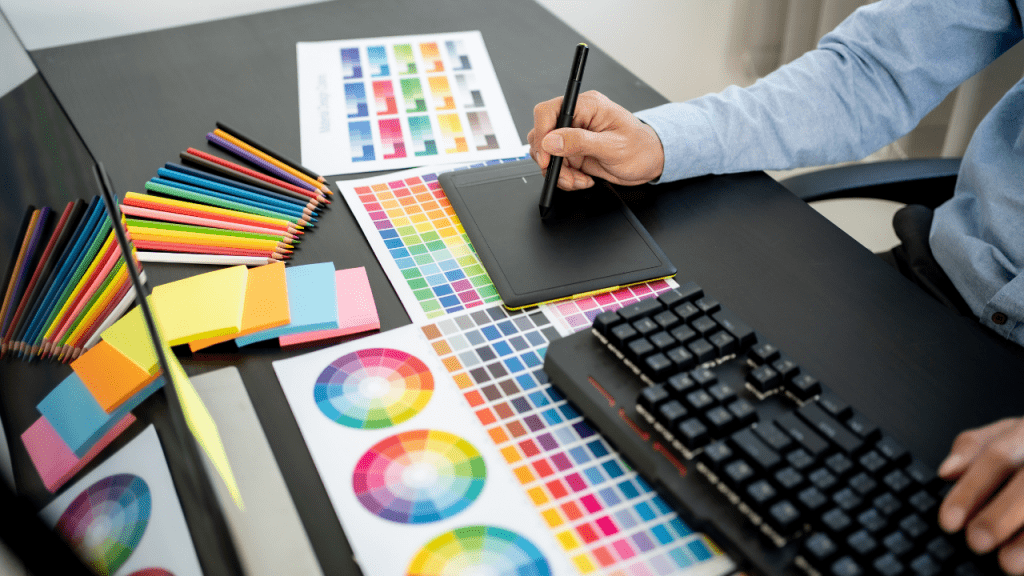Whether it’s a design, website, poster, logo, packaging or mobile app, the mockup is a real asset for presenting your design to your customer. It gives them an overview of your project. Generally speaking, mockups downloadable from the Internet are often usable on software such as Photoshop or Illustrator. But, if you’d like to know how to create a logo or packaging mockup, this article serves as a guide.
What is a mockup?
A mockup or mock-up is an editable image file used to designate a mock-up on which you can change (add or remove) certain content elements, such as : an image, a video, etc.
In principle, the mock-up is relatively very simple, allowing the content to stand out. It’s not the final version of a visual, rather a rough draft. The mockup is used in many ways : for website design, business cards, flyers, etc.
The aim of a mock-up is to get a message across in an original way with a more visionary, design-led communication medium.
Why use a logo or packaging mockup?
The use of mockups serves not only to communicate well, but also to satisfy customers. As such, visual aids are just as effective as content. And this is always true whether it’s a digital communication medium or a physical one.
When it comes to designing a website or mobile app design, in other words, a digital tool, the mockup is an essential approach that enables :
- Give customers a preview of the interface
- Control the general appearance of the display (placement and sizes of elements, technical impossibility…)
- Manage the placement of each element to improve the interface
- Better assess the intelligence of an interface, which also helps to better estimate design time
- Easily modify the interface before developers work on it. In terms of speed, it’s always better to make changes upstream than during integration or development.
What are the most popular tools for creating a logo or packaging mockup?
Creating logo and packaging mockups is crucial to visually presenting design concepts in a realistic and professional way. Here are some of the most popular tools used by designers for this task.
Adobe Photoshop
Adobe Photoshop is widely preferred for its flexibility and advanced features. Designers use its photo editing and layer creation capabilities to integrate logos and designs on realistic packaging. Staging options and lighting effects make for impressive final renderings.
Adobe Illustrator
Adobe Illustrator is ideal for creating vector logo mockups, offering perfect precision and scalability. Designers use its drawing and shape manipulation tools to create precise logo mockups on a variety of media.
Mockup World
Mockup World is an online resource offering a vast collection of free and paid mockups for various types of products and media. Designers can easily download and customize these mockups to showcase their logos and designs on real products.
Canva
Canva is a user-friendly tool for creating designs, including logo and packaging mockups. With its ready-to-use templates and simple customization tools, designers can quickly assemble attractive visual presentations.
Sketch
Sketch is prized for its ease of use and focus on user interface and user experience. Although primarily used for interface design, it is also used to create logo and packaging mockups with its plugins and collaboration features.
Using these tools, designers can effectively present their creations in a professional manner, helping to visualize and validate their design ideas with their customers and target audience.
What are the steps involved in creating a logo or packaging mockup?
Creating a logo or packaging mockup is essential for visualizing and presenting your creations in a professional way. Whether for clients or your own portfolio, a well-crafted mockup can bring your design ideas to life. Follow this detailed guide to discover the simple, effective steps for creating attractive, realistic mockups.
Step 1: Preparing design elements
Before you start creating the mockup, make sure you have all the necessary design elements. These include the logo or packaging illustration, the colors and fonts used. These elements should be ready to be integrated into your mockup.
Step 2: Choose the right tool
Select the mockup creation tool that best suits your needs. Photoshop is often preferred for its flexibility and advanced image manipulation options. You can also use online tools or specialized software such as Adobe Illustrator for vector designs.
Step 3: Creating the background or environment
Start by creating the background or environment on which your logo or packaging will be placed. Choose a neutral or contextual background that will enhance your design without overpowering it. Use separate layers for greater flexibility when adjusting placement.
Step 4: Main design integration
Import your logo or packaging design into the mockup. Use the transformation and scaling tools to adjust the size and position of the design according to your preferences. Be sure to align the design correctly with the environment created for a realistic rendering.
Step 5: Add detail and realism
To make your mockup more realistic, add details such as shadows, reflections and textures. Use shading layers to create natural shadows that simulate environmental lighting. Reflections can be added to imitate shiny surfaces such as glass or metal.
Step 6: Review and final adjustments
Review your mockup to ensure that all elements are correctly integrated and that the design is professionally presented. Make any necessary adjustments to colors, shadows or design layout to achieve the desired result.
Step 7: Export and share
Once you’re happy with the finalized mockup, export it in the appropriate format (for example, PNG or high-resolution JPEG). Be sure to keep an editable version of the mockup in case further adjustments are needed. Share your mockup with your customers or include it in your portfolio to showcase your design skills.
Conclusion
By following these simple but strategic steps, you can create logo or packaging mockups that will impress with their realism and professionalism. Using the right tools and mastering design techniques will enable you to showcase your creations effectively and aesthetically. Don’t be afraid to experiment with different styles and configurations. This will enable you to find the mockup that perfectly matches your needs and those of your customers.
However, to create a logo or packaging mockup, software such as Photoshop or Illustrator are ranked among the best, given that these programs are dedicated to professionals. But, to have a quality logo or packaging mockup, call in a graphic design expert.
Vous avez aimé cet article ? Aidez-nous en mettant 5 étoiles !
Your page rank:









